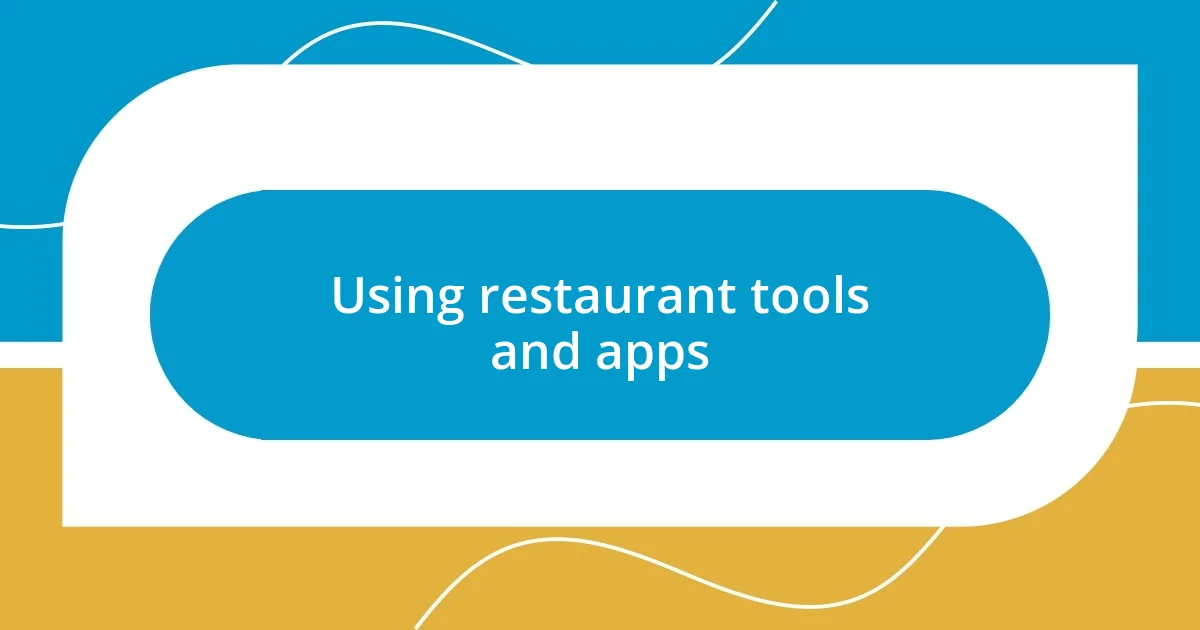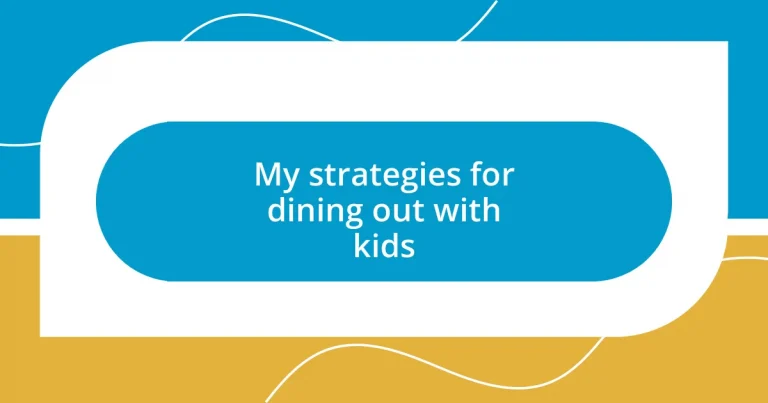Key takeaways:
- Choosing family-friendly restaurants with a relaxed atmosphere, diverse menus, and kid-focused amenities enhances the dining experience for families.
- Planning meals in advance by discussing options and pre-selecting shareable dishes builds excitement and encourages kids to try new flavors.
- Engaging kids through playful activities, involving them in decision-making, and using positive reinforcement helps manage expectations and fosters adventurous eating habits.

Choosing family-friendly restaurants
When I’m on the hunt for a family-friendly restaurant, I always look for the buzz of happy children and the aroma of comforting meals. Places that have a relaxed atmosphere can really make a difference—remember that time my little one decided it was the perfect moment to perform his newfound dance moves in the middle of the dining area? Instead of glaring looks, we were met with chuckles and smiles from the staff and other diners. That’s the vibe I seek; it’s reassuring and sets the tone for a fun outing.
I also pay close attention to the menus. Are there kid-friendly options that aren’t just chicken nuggets or plain pasta? I’ve found that restaurants offering diverse and nutritious choices can make meals more enjoyable for both my children and me. It’s about finding the balance between keeping them happy and making sure we’re all eating well. Have you noticed how a colorful menu can spark a child’s interest? It’s a little victory when they want to try something new!
Finally, consider the amenities a restaurant offers. High chairs, changing tables, or even play areas make dining out so much smoother. I remember one occasion when a restaurant had a small play corner where my kids could let loose while waiting for their food. It felt like a mini-vacation for me! What features have you found to be essential in choosing a spot that keeps everyone happily seated?

Planning meals in advance
When it comes to dining out with kids, planning meals in advance can be a game changer. I often browse the restaurant’s menu ahead of time, which allows me to discuss options with my children before we even arrive. This not only builds excitement but also helps to manage their expectations, especially if they’re picky eaters. For instance, knowing there’s a delicious veggie pizza can often win over my youngest, even if he typically leans towards simpler choices.
Another tactic I find invaluable is pre-selecting a couple of dishes we can share as a family. I remember a night out where we chose three shareable plates, and it turned into an impromptu tasting session. Each of us picked something we were curious about—our table turned into a vibrant spread that prompted my kids to try flavors they wouldn’t usually go for. This approach doesn’t just keep things interesting, but it also makes the dining experience feel more like an adventure.
Lastly, I suggest connecting with the restaurant staff ahead of time if possible, especially when it comes to any dietary restrictions. I reached out once about vegan options for my oldest, and the staff was incredibly accommodating, even suggesting modifications for existing dishes. Being proactive not only eases any concerns but fosters a sense of trust, ensuring that our meal is not only enjoyable but also safe for my little ones.
| Strategy | Description |
|---|---|
| Pre-Menu Exploration | Review the menu beforehand to prep discussions with kids |
| Family Sharing | Choose shareable plates for a fun tasting experience |
| Staff Communication | Talk to staff about dietary needs for a safer experience |

Managing the kids’ expectations
When it comes to managing kids’ expectations, I find that open communication is essential. Before we head out, I share details about the restaurant, the type of food they serve, and what my kids can expect. I recall a particular dinner when I excitedly told my daughter about a place famous for its unique dessert menu. Her eyes lit up, and that made the wait for dinner feel more like an adventure. By setting the scene, I keep their enthusiasm high and remind them that dining out can be a delightful experience.
Additionally, I like to involve my kids in the decision-making process. This not only empowers them but also helps temper their expectations. I often say things like:
- “What do you think you’ll want to try?” This sparks their imagination.
- “We might have to wait a little bit for our food.” Understanding the timeframes helps mitigate impatience.
- “Remember, it’s new and we might love it!” Encouraging an open-minded attitude can lead to festive culinary discoveries.
All of this feeds my belief that managing expectations isn’t just about explaining; it’s about creating a sense of anticipation that transforms the dining experience into a family storytelling moment. I know that when my children feel involved, their excitement turns into a shared enthusiasm that makes our outings all the more enjoyable.

Using restaurant tools and apps
Using restaurant tools and apps can really streamline the dining-out experience with kids. I often rely on apps that allow us to view the menu online before our visit. It might sound simple, but this small step helps my kids feel more involved. Recently, while browsing a family-friendly app, my daughter was able to explore a range of options that excited her, almost like a treasure hunt for food choices. Isn’t it incredible how technology can spark enthusiasm and ease the stress of eating out?
Another tool I appreciate is the capability to order ahead through various restaurant apps. I recall a busy Friday evening when we visited a popular pizza place. By placing our order in advance, we were able to skip a long wait that might have led to restless kids. Instead, we arrived, grabbed our food, and spent more time enjoying our family meal rather than fidgeting. This strategy not only saves time but also turns potential frustrations into happy moments that we can share.
Don’t overlook the power of rating and reviewing platforms either. I frequently check previous diners’ experiences when selecting a restaurant. I remember coming across a review about a local diner known for exceptionally quick service. That insight helped us choose it for our last outing, and boy, was it a hit! By doing a bit of research, I not only discovered a worthwhile spot but also made our outing pleasant, keeping my kids engaged without the common challenges of long waits and uncertainties. Who knew these digital tools could enhance our dining adventures so much?

Keeping the dining experience fun
Keeping the dining experience fun often hinges on creativity and playfulness. I like to turn waiting time into a game by playing “I Spy” or “20 Questions.” Not too long ago, while waiting for our food at an Italian restaurant, my son spotted a colorful mural and declared it would be our “clue” for the game. Before we knew it, we were laughing and making up stories about the characters on the wall. It’s amazing how these little activities can transform a moment of impatience into delightful family bonding.
Another trick I’ve found effective is involving my kids in the dining experience as much as possible. For instance, when we visit a casual eatery, I ask them to pick out fun drinks or sides. Just last month, my daughter chose a unique soda flavor that she’d never tried before. Her eyes sparkled with excitement, and we ended up discussing what flavors and combinations we enjoyed at home. Making decisions and experiences feel special for my kids keeps them engaged, and it fuels their desire to explore new things.
It’s also crucial to embrace spontaneity during mealtime. One time, after finishing our meal at a diner, we noticed a small stage where local musicians were performing. Instead of rushing to leave, we decided to stick around and listen. That unexpected concert turned an ordinary dinner into a memorable evening filled with music, laughter, and impromptu dancing. I often ask myself, “What serendipitous moments might we miss if we stick too rigidly to our plans?” These unplanned experiences are what truly make dining out a cherished family tradition.

Handling picky eaters effectively
When it comes to handling picky eaters, one effective strategy I’ve embraced is the “taste-test” approach. Recently at a taco joint, I ordered a variety of small tacos to share. As we passed around the colorful plates, my daughter surprised me by eagerly trying a mango salsa she usually wouldn’t touch. It was a game changer! Encouraging kids to sample small bites can often break down their resistance to new flavors—what’s not to love about a mini food adventure?
Another important factor is to avoid pressure. Instead of emphasizing a “clean plate” rule, I like to celebrate any progress they make. I remember a meal at a casual café where my son took just one bite of a veggie burger. Instead of insisting he finish it, I praised him for being brave enough to try something different. It’s amazing how positive reinforcement can open the door to more adventurous eating. What if we shifted our focus away from the food itself and towards the experience of trying something new together?
Lastly, I often involve my kids in meal preparation when we’re at home, which sets the stage for our dining-out experiences. For example, after we donned our aprons and made homemade pizza together, they felt much more inclined to try different toppings when we hit a pizzeria. Could it be that hands-on involvement creates a sense of ownership over food choices? In my experience, sharing in the cooking process cultivates an openness to explore new flavors, transforming picky eaters into little food explorers.














